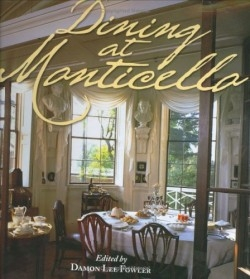Dining at Monticello
In Good Taste and Abundance
Most scholars and laypeople agree that Thomas Jefferson was a Renaissance man. But scholarly treatments of his accomplishments in government, literature, philosophy, and invention omit his influence on the culinary world. Curious minds need worry no more, thanks to this extremely illuminating collection of essays and recipes.
The first of two sections contains ten essays by “Monticello experts and outside scholars,” whose credentials range from senior historian of the Thomas Jefferson Foundation, to a research historian at the Robert H. Smith International Center for Jefferson Studies at Monticello, to the associate curator of collections and the director of gardens and grounds at Monticello.
The editor is a culinary historian and food writer who has edited two historical cookbooks and written five, including Classical Southern Cooking: A Celebration of the Cuisine of the Old South, nominated for awards from Julia Child and the James Beard Foundation. Here, his topics range from how Jefferson’s food was prepared to how groceries were acquired to the social dynamic within the kitchen’s hierarchy.
Jefferson loved to entertain; his epicurean talent “resonates with food lovers across the ages not because he mastered haute cuisine, but because he understood its principles,” writes the editor in his opening essay, “Jefferson’s Place in American Food History.” Fowler praises the president’s culinary influence and vision: “he made drawings of a pasta machine, an apple press, tureens, coffee urns, and cruets.”
The book’s essays include “Nourishing the Congress: Hospitality at the President’s House,” by Lucia Stanton, and a piece by Justin A. Sarafin, project coordinator for the restoration of Monticello’s “dependencies”—the outbuildings that served as cook rooms and storage facilities. Sarafin writes about how the Jefferson household ran “Like Clockwork: French Influence in Monticello’s Kitchen,” with a crime-scene-style sidebar on how the exact layout of the kitchen was determined.
Elizabeth V. Chew discusses the role of Jefferson’s female relations in “Carrying the Keys: Women and Housekeeping at Monticello.” Several of Jefferson’s “enslaved persons” were trusted with great authority and household responsibilities, but that could be due to the ennui the women felt about the tasks. She quotes Mary Randolph, a Jefferson granddaughter: “the functions I perform … are exactly as a machine might be made to perform with equal success, locking and unlocking doors, pouring out tea and coffee and in the interim plying my needle.”
Dianne Swann-Wright, curator at the Frederick Douglass—Isaac Myers Maritime Park, in her essay “African-American Participation on Monticello’s Food Culture,” notes the importance of James Hemings as Jefferson’s favorite chef, and describes the slaves’ fare at Monticello. Some of the book’s contributions tend to overlap and repeat (like essays on “Thomas Jefferson’s Table: Evidence and Influence”; “Dining at Monticello: The ‘Feast or Reason’”; and “Jefferson and Wine: A ‘necessary of life’”).
Gaye Wilson writes about the arduous task of keeping the larder stocked in “‘A Declaration of Wants’: Provisioning the Monticello Table,” while Peter Hatch describes “Thomas Jefferson’s Favorite Vegetables.” The estate’s grounds included a tremendous garden; another sidebar discusses whether Jefferson was a vegetarian.
The second (and more interesting and useful) portion of Dining at Monticello offers seventy-five period recipes, some of which are said to be Jefferson’s own. The collection keeps the spirit of the eighteenth- and nineteenth-century entries, while making them reproducible in a modern kitchen. Included with the instructions are “cook’s notes,” by Fowler and coordinator Beth Lonvick Cheuk, detailing ingredients, cookware, procedures, and anecdotes.
There are recipes for soups, entrees, and side dishes. Of particular charm and interest are the desserts: “The Jefferson family manuscripts are filled with puddings, pastries, and sweets, which in large part shows that as elsewhere, at Monticello, desserts and other baking of upper-class households were the provenance of the mistress. … The women controlled desserts in part because sugar was an expensive commodity.” This explanation doesn’t quite answer the sidebar question, “Why are there so many desserts?” but it demonstrates that even in those days, consumers had to watch their pfennigs.
If the book consisted only of text, it would be well worth the price, but Fowler has enhanced the volume with lush photographs of the famous estate’s grounds and interiors.
Just when readers might think there’s no aspect of a colonial celebrity’s life left to examine, Dining at Monticello: In Good Taste and Abundance proves that a study of a Renaissance man at table can make a fascinating read.
Reviewed by
Ron Kaplan
Disclosure: This article is not an endorsement, but a review. The publisher of this book provided free copies of the book to have their book reviewed by a professional reviewer. No fee was paid by the publisher for this review. Foreword Reviews only recommends books that we love. Foreword Magazine, Inc. is disclosing this in accordance with the Federal Trade Commission’s 16 CFR, Part 255.

